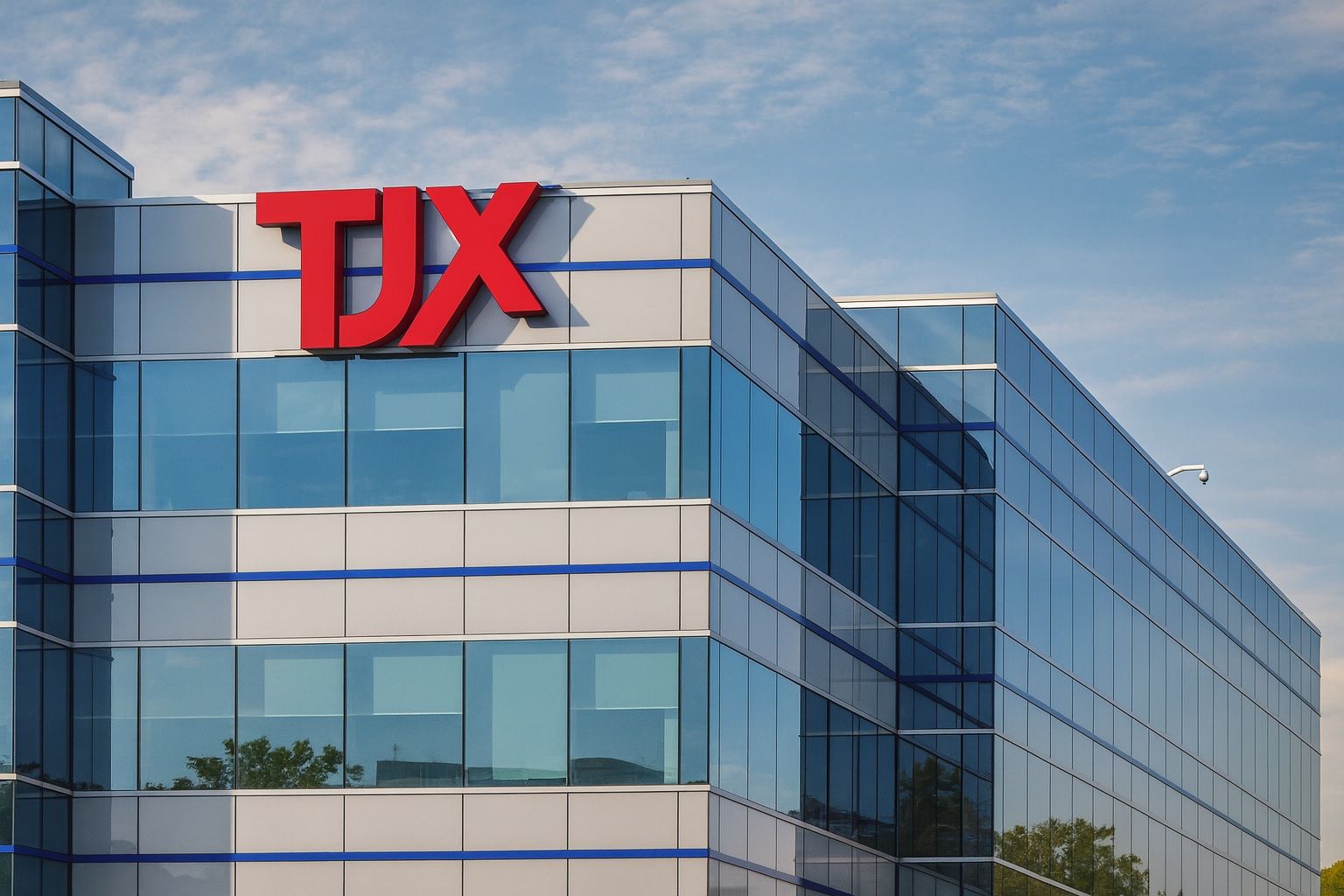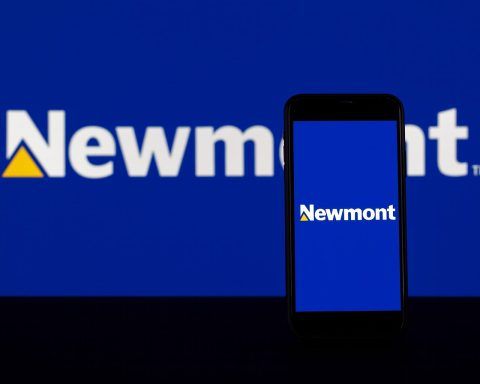The TJX Companies, Inc. (NYSE: TJX), the off‑price powerhouse behind T.J. Maxx, Marshalls, HomeGoods and TK Maxx, posted stronger‑than‑expected third‑quarter Fiscal 2026 results and raised its full‑year profit outlook again, underscoring how inflation‑weary shoppers continue to trade down to value retailers. [1]
Net sales climbed to about $15.1 billion in Q3 FY26, up roughly 7% year over year, while consolidated comparable sales grew 5%, comfortably ahead of both the company’s own plan and Wall Street expectations. Diluted earnings per share rose around 12% to $1.28, beating analyst estimates of roughly $1.22–$1.23. Pretax profit margin widened to 12.7%, also above guidance. [2]
On the back of this outperformance, TJX increased its Fiscal 2026 EPS guidance to $4.63–$4.66 (from $4.52–$4.57 previously) and now expects full‑year comparable sales to grow about 4%, up from a prior 3% outlook. [3]
In early trading, TJX shares were up around 2.5–3%, hovering near the high‑$140s and extending a gain of more than 20% year‑to‑date, leaving the stock close to record territory. [4]
Key Q3 FY26 numbers at a glance
According to the company’s Q3 earnings release and market data, these are the headline figures investors are watching: [5]
- Net sales:
- $15.1–$15.12 billion, up about 7–7.5% year over year
- Beat consensus expectations near $14.85 billion
- Comparable sales:
- +5% consolidated comps, vs. roughly +3.7% expected by analysts
- Well ahead of management’s prior Q3 plan of +2% to +3% set back in August [6]
- Profitability:
- Pretax profit margin:12.7% (up 40 basis points from 12.3% a year ago)
- Gross margin: about 32.6% vs. 31.6% last year
- SG&A: roughly 20.1% of sales, modestly higher due to wages, bonuses and charitable contributions
- Earnings:
- Net income: about $1.4 billion, up from roughly $1.3 billion in the prior‑year quarter
- Diluted EPS:$1.28 vs. $1.14 last year and around $1.22–$1.23 expected
- Year‑to‑date performance (first nine months FY26):
- Net sales:$42.6 billion, up about 7% vs. last year
- Consolidated comps:+4%
- EPS:$3.30 vs. $3.03 a year earlier (about 9% growth) [7]
- Capital returns:
- $1.1 billion returned to shareholders in Q3 through buybacks and dividends
- FY26 plan to return roughly $2.0–$2.5 billion in total, in line with earlier guidance [8]
These numbers reinforce the narrative that TJX is not just a “trade‑down beneficiary” of inflation, but also a disciplined operator that’s steadily expanding margins while still reinvesting in stores and inventory.
Guidance raised again for FY26 – and what changed
This is the second time in FY26 that TJX has boosted its full‑year outlook. After a strong second quarter, the company had already nudged guidance higher to EPS of $4.52–$4.57 and a pretax margin range of roughly 11.4–11.5%. [9]
Following today’s Q3 beat, management is going further: [10]
- Full‑year FY26 EPS: now $4.63–$4.66
- Full‑year comparable sales: now about +4% (up from +3%)
- Full‑year pretax margin: described by analysts as mid‑11%, slightly above the prior range
For the fourth quarter FY26 (the critical holiday period), TJX now expects:
- Comparable sales:+2% to +3%
- EPS:$1.33–$1.36, just below the roughly $1.37 Wall Street was modeling [11]
Management notes that Q4 is off to a “strong” start and that merchandise availability is “outstanding,” but the more conservative comps outlook signals some caution around macro volatility and lapping last year’s strong holiday season. [12]
Off‑price model shines as shoppers trade down
The story behind the numbers is straightforward: value is winning.
TJX operates one of the world’s largest off‑price retail networks, with more than 5,100 stores across the U.S., Canada, Europe and Australia under banners including T.J. Maxx, Marshalls, HomeGoods, Homesense, Winners and TK Maxx. [13]
Several demand drivers came through in Q3:
- Inflation‑strained consumers are hunting for deals. Household budgets remain under pressure, and shoppers continue to favor discounted branded apparel and home goods over full‑price department stores. [14]
- Seasonal shift & back‑to‑school strength. A quicker move from late‑summer to fall assortments, combined with robust back‑to‑school demand, helped drive traffic and ticket growth in the U.S. banners, according to commentary around the quarter. [15]
- Broad sourcing cushions tariffs and costs. TJX’s long‑running strategy of buying opportunistically from thousands of vendors allows it to re‑mix inventory quickly, helping it sidestep some tariff and freight pressures that others feel more acutely. [16]
Segment and regional performance, based on company and analyst summaries, underscores the breadth of the strength: [17]
- Marmaxx (T.J. Maxx, Marshalls, Sierra in the U.S.): roughly +6% comps
- HomeGoods/Homesense (U.S.): about +5% comps
- TJX Canada: high‑single‑digit comp growth
- TJX International (Europe & Australia): low‑ to mid‑single‑digit comp gains
In other words, this wasn’t a one‑banner or one‑category story. TJX is seeing momentum across apparel, accessories and home, and across geographies.
Margins march higher despite cost headwinds
One of the most striking aspects of Q3 is how profitability expanded even as TJX continued to invest in labor and philanthropy.
From the company’s detailed margin breakdown: [18]
- Pretax margin:
- Up to 12.7% from 12.3% last year (+40 bps)
- Around 60 bps above the high end of the company’s own plan
- Gross margin:
- Improved by roughly 100 bps to about 32.6%
- Driven by higher merchandise margins and lower freight costs, plus scale leverage on stronger‑than‑planned sales
- SG&A:
- Rose to roughly 20.1% of sales (+60 bps year over year)
- Reflects higher store labor, increased incentive compensation and a contribution to the TJX Foundation
While SG&A costs ticked higher, the gross margin expansion more than offset the pressure, allowing overall profitability to improve. On an annual basis, the company’s pretax margin target in the mid‑11% range sits well above its most recently reported net profit margin of about 8.6% for the year ended January 31, 2025, highlighting the leverage the off‑price model continues to deliver. [19]
Inventory also looks healthy rather than bloated. Analyses of recent filings suggest per‑store inventory is up in the high single digits year over year, reflecting strong buying opportunities rather than slow‑moving product, with management emphasizing “fresh assortments” as a key traffic driver heading into the holidays. [20]
How the market is reacting to TJX stock
The earnings beat and guidance hike are being well‑received on Wall Street:
- Share price reaction: TJX shares climbed roughly 2.5–3% in pre‑market trading, to around $149, after the report. [21]
- Year‑to‑date performance: The stock is up about 20–21% so far in 2025, outpacing the broader market. [22]
- Analyst stance:
- Market data show a “Buy” consensus from about 22 analysts
- The average 12‑month price target sits near $153, implying modest additional upside from recent levels. [23]
Several major firms have already been inching price targets higher in recent weeks, citing TJX’s resilient traffic, solid execution and ability to raise guidance even in a choppy macro environment. [24]
ESG and long‑term positioning
Beyond the quarter’s numbers, TJX continues to lean on a set of long‑term sustainability commitments that increasingly matter to institutional investors and younger shoppers alike. Among its headline environmental goals: [25]
- Net‑zero greenhouse gas emissions in its own operations by 2040 (Scope 1 and 2)
- 100% renewable electricity in its operations by 2030
- Divert 85% of operational waste from landfill by 2027
Brand‑specific sites for HomeGoods, Homesense and TK Maxx echo these same targets and highlight progress, including high waste‑diversion rates already achieved in some regions. [26]
While these ESG initiatives don’t directly drive today’s earnings beat, they do support TJX’s long‑term license to operate and can help mitigate regulatory and reputational risks as environmental standards tighten globally.
Risks and what to watch next
Despite the upbeat quarter, there are real risks investors and industry watchers should keep on their radar:
- More cautious Q4 comp guidance. Management is only calling for 2–3% comp growth in the holiday quarter, well below Q3’s 5% pace and slightly under consensus expectations, suggesting some prudence around consumer spending and competitive promotions. [27]
- Macro uncertainty. Persistent inflation, higher interest rates and student‑loan repayments could all weigh on discretionary spending, even at value‑focused retailers.
- Tariffs and freight costs. While TJX’s flexible sourcing model has helped blunt tariffs and transportation costs so far, any sharp reversal in freight rates or new trade policies could pressure margins. [28]
- Valuation risk. With the stock near record highs and trading at a premium to many traditional retailers, any stumble on comps or margins could trigger a sharper‑than‑usual pullback. [29]
Key catalysts to watch in the coming weeks include:
- Commentary from today’s 11:00 a.m. ET earnings call, where management is expected to provide more color on holiday trends, inventory and traffic. [30]
- Holiday sales updates from other off‑price peers and big‑box competitors, which will show whether TJX’s outperformance is company‑specific or part of a broader value‑retail wave.
- Any updates on store growth, e‑commerce initiatives and international expansion, particularly in Europe and Canada.
Bottom line
TJX’s latest quarter checks all the boxes investors like to see:
- Sales beat expectations
- Margins expanded
- Earnings topped forecasts
- Guidance went up
- Cash flows and shareholder returns remain robust
In a retail landscape where many brands are still struggling to find footing after the pandemic and amid sticky inflation, the T.J. Maxx / Marshalls / HomeGoods owner continues to demonstrate that the off‑price treasure‑hunt model is not only resilient but thriving.
For now, the message from today’s results is clear: value retail is still in demand, and TJX is one of its strongest operators.
This article is for informational purposes only and does not constitute investment advice. Investors should conduct their own research or consult a financial advisor before making investment decisions.
References
1. www.businesswire.com, 2. www.businesswire.com, 3. www.reuters.com, 4. www.reuters.com, 5. www.businesswire.com, 6. www.businesswire.com, 7. www.businesswire.com, 8. www.businesswire.com, 9. www.businesswire.com, 10. www.reuters.com, 11. www.marketscreener.com, 12. www.businesswire.com, 13. www.businesswire.com, 14. www.reuters.com, 15. www.reuters.com, 16. www.reuters.com, 17. www.ainvest.com, 18. www.businesswire.com, 19. www.alphaquery.com, 20. www.businesswire.com, 21. www.marketscreener.com, 22. www.reuters.com, 23. www.marketscreener.com, 24. www.marketscreener.com, 25. www.smartenergydecisions.com, 26. www.homegoods.com, 27. www.marketscreener.com, 28. www.reuters.com, 29. www.marketscreener.com, 30. www.businesswire.com









